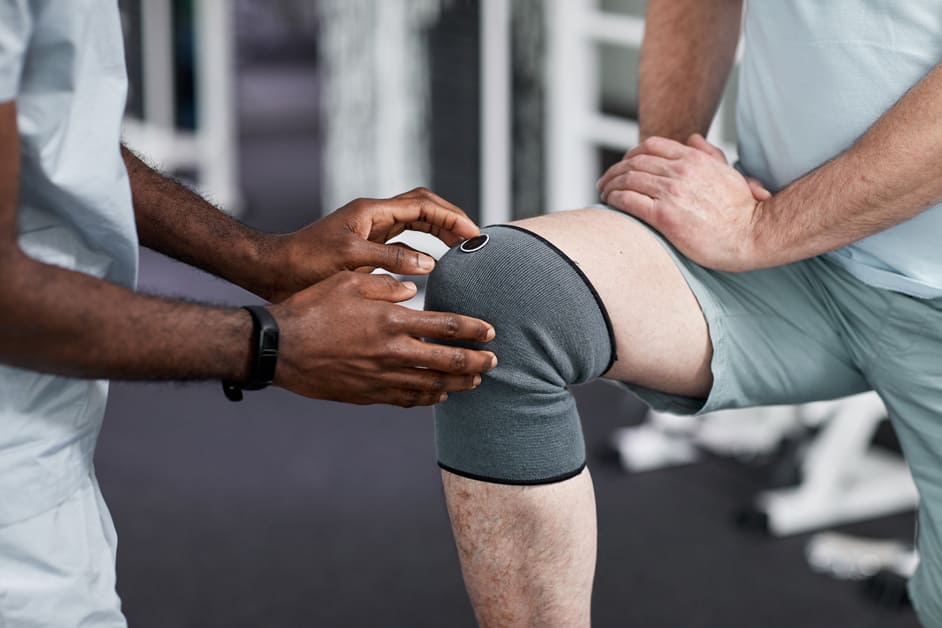Introduction
Exercising when pregnant is essential for your physical and emotional well-being. But as your baby grows, knee pain could be a problem. Pregnancy triggers the release of relaxin, a hormone that helps your body prepare for birth by loosening your joints and ligaments. This can lead to pain and soreness in your knees when you exercise.
Here are some tips to consider when trying to avoid knee pain during exercise during pregnancy:
- Wear supportive shoes that provide cushioning and stability.
- Stretch your calf muscles and hamstrings before and after exercising.
- Avoid high-impact activities such as running or jumping.
- Choose low-impact activities such as swimming, walking, and prenatal yoga.
- Strengthen your core and glutes to help support your knees.
- Listen to your body and stop if you experience any pain.
Warm Up
Pregnant women should always warm up before physical activity. Especially when it comes to knee pain. Take time to stretch joints and muscles. This warm up will help loosen muscles and joints. It increases blood flow and reduces the risk of knee pain. Doing this will help with optimal performance and reduce the risk of injury.
Stretching
Stretching is important for physical activity. It warms and cools down muscles. It also helps prevent knee pain and reduces the risk of injury. It improves balance, enhances performance and is beneficial for pregnant women. It increases movement, circulation and reduces the risk of injury.
Start your stretching slowly. Focus on individual joints to increase flexibility. Use gentle stretches that are held for 10-15 seconds. Avoid bouncing movements which could cause joint pain, especially in pregnancy.
Here are a few examples of stretching exercises to reduce knee pain:
- Hamstring Stretch: Lie flat on your back with legs straight. Lift one knee towards your chest and hold for 10-15 seconds. Repeat with other leg.
- Bycicle Stretch: Lie flat on your back. Extend one leg and bend the other to 90°. Hold onto behind thigh or ankle and bring towards sternum. Hold for 10-15 seconds. Alternate legs and repeat.
- Butterfly stretch: Sit upright. Fold both knees outward and keep soles of feet together. Grasp ankles/calves/feet and push knees lower. Feel a mild stretch in inner thighs. Hold for 10-15 seconds. Alternate legs if desired.
Cardiovascular Exercise
Pregnant women can increase their heart rate with cardio exercise. It’s a safe way to prepare the body for more physical activity. But, don’t overwork the joints. Focus on warming up, not full-on exercise. Light cardio and dynamic stretching are best. This involves movements that boost flexibility. Leg extensions and swings can help prevent injury.
Once your body is warm, you can do further physical activity. If running or jogging is your preferred form, pay attention to your technique. This can stop unnecessary stress on the knees. Watch out for fatigue too. Weak muscles can cause knee pain.
After cardio, strength training is a great idea. This keeps your joints strong, so they don’t get injured. Keep an eye out for inflammation in your knee joints. Don’t continue if you have pain.
Exercise Techniques
Pregnancy = tons of health benefits! Exercise helps boost energy, reduce stress and soothe discomforts like backaches and constipation. But it’s key to practice safe exercise techniques to avoid knee pain! Here are some tips for pregnant women to help them steer clear of any knee woes:
Squats
Squats are a great exercise during pregnancy. They help strengthen your legs and reduce knee pain. But, exercise with caution:
- Distribute your weight evenly on your feet and keep your chest lifted.
- Contract your abs before each squat.
- Don’t strain yourself. Take breaks if needed.
- For added balance, use a chair or wall for support.
- Keep your feet hip-width apart.
- Always follow your doctor’s orders.
Lunges
Lunges are a great way to build strength and balance in the lower body. But pregnant women must take extra precautions. Poor form can put strain on the knees, which can be worse for pregnant women due to altered posture and center of gravity.
To lunge safely during pregnancy:
- Start with a narrow stance and descend slowly.
- Focus on pushing off your front heel as you come back up.
- Keep your back knee close to the ground, not beyond your front foot.
- Stay upright during each rep.
- If it starts to hurt, modify the lunge with hands against a wall or bench.
- Stop immediately if any strange sensations occur.
Step-Ups
Step-ups are great for toning legs, hips, abs and glutes. To do this exercise, step onto and down from a raised surface using one foot at a time. Make sure to place weight on your heels not the ball of your foot to avoid knee pain. Step-ups involve some core stability too. As you go up, press through your abs and glutes.
Be careful when performing step-ups. If you experience any discomfort or pain in your knees, stop immediately. Before attempting any exercise program during pregnancy, always consult with a healthcare professional.
Leg Lifts
Leg Lifts are a great exercise for pregnant women. Keep your legs fit and limber without straining your knee joints. Start by lying flat on the floor, with your back straight and hands at your sides. Raise one leg off the floor with a slow, steady motion. Hold light weights to increase intensity. Alternate legs throughout a set of reps. Keep your torso still. Isolate and strengthen your legs. Support proper posture to ease knee pain.
Cool Down
Exercising while preggers can help keep weight and bod in shape. However, you need to watch out for knee pain and other injuries. Cooling down is a must-do after your workout routine. It helps the body return to its pre-exercise state and thus reduces the risk of knee pain.
Let’s discuss the importance of cooling down and how to do it well when pregnant:
Stretching
Stretching is essential for athletes, but especially for pregnant women. After a workout, do some dynamic stretches like arm circles and leg swings. These will help you identify your range of motion and tighten muscles to prevent injury.
Cool down by stretching for 10-15 minutes. Start with stretches that involve multiple joint motions, like walking lunges. This will reduce lactic acid build-up in the muscles. Then move onto static stretches, like quadriceps holds, to increase flexibility in the body.
Perform deep tissue stretches for the lower back and hips a few times per week. This helps pelvic joint stability during pregnancy. Make sure to keep a flat back to avoid putting pressure on abdominal organs. Don’t forget to stretch! It helps prevent knee pain during pregnancy.
Foam Rolling
Foam rolling is a type of self-massage. It helps relieve pain and tight muscles. It’s great for avoiding knee pain when exercising. No special equipment is needed.
To do it, lie on your back with a foam roll under one leg. Roll from the knees to the hips. Do this slowly with pressure. If an area is sensitive, pause there for a few seconds. You can also roll your calves and thighs. This helps reduce tension in muscles which can lead to knee pain.
Conclusion
It is essential to remember that each pregnancy is unique. Even with preventive care, knee pain can still occur. Pay attention to your body’s movements. Stretch before and after workouts. Avoid high-impact activities. Use supportive devices such as knee sleeves or braces when needed.
These tips will decrease the risk of discomfort or pain while exercising. Also, it will limit recovery time from any physical activity-related discomfort during pregnancy. Taking care of yourself and baby is the priority.
Follow these simple tips on how to prevent knee pain during exercise for safety and comfort:
- Stretch before and after workouts.
- Avoid high-impact activities.
- Use supportive devices such as knee sleeves or braces when needed.
Frequently Asked Questions
Q: What exercises can pregnant women do to reduce knee pain?
A: Low-impact aerobic exercises such as walking, swimming, and stationary cycling are great for pregnant women. Strengthening exercises for the hamstrings, quadriceps, and glutes can also help to reduce knee pain. Additionally, stretching exercises such as yoga can help to maintain flexibility in the knee joints.
Q: What can I do to prevent knee pain during exercise?
A: It is important to warm up and cool down properly before and after exercise. Wearing supportive shoes and using the proper form while exercising can also help to reduce knee pain. Additionally, rest days are important to allow the body to recover and to prevent overuse injuries.
Q: Are there any other tips to prevent knee pain during exercise?
A: It is important to stay hydrated and to fuel your body with the proper nutrients. Additionally, it is important to listen to your body and stop exercising if you experience any pain or discomfort.





